Alexei Yegorovich Yegorov
Alexei Yegorovich Yegorov (Russian: Алексей Егорович Егоров; c.1776 - 22 September 1851, Saint Petersburg) was a Russian painter, draftsman and professor of history painting.
Alexei Yegorovich Yegorov | |
|---|---|
| Алексей Егорович Егоров | |
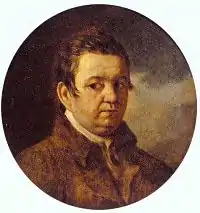 Self-portrait | |
| Born | 1776 |
| Died | September 10, 1851 (aged 74–75) |
| Education | Member Academy of Arts (1807) |
| Alma mater | Imperial Academy of Arts (1797) |
| Known for | Painting |
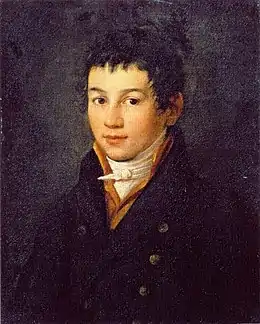
(late 1790s)
Biography
He was taken captive by Cossacks as a young child and later placed in the Moscow Orphanage. Little was ever learned of his origins although, based on some of his early memories, he was believed to be of Kalmyk descent.[1]
In 1782, he was enrolled at the Imperial Academy of Arts, where he studied with Ivan Akimov and Grigory Ugryumov.[2] He graduated in 1797 and became an academician in 1803, following which he was sent to do field work in Rome and came under the influence of Vincenzo Camuccini, who praised the simplicity of his design and coloring.[3] Larger than the average Italian, he was nicknamed the "Russian Bear". It was rumored that people would buy his paintings for the number of gold coins that could be laid on the principal figure, and that Pope Pius VII had asked him to remain as a court painter, but he politely refused the offer.[1]
In 1807, he returned to Saint Petersburg and became an assistant professor at the Academy.[1] He also gave private drawing lessons to Elizabeth Alexeievna[2] and Alexander I, who gave him a nickname, "The Renowned" (знаменитого), after he completed a fresco with over a hundred figures ("World Prosperity") at Tsarskoye Selo in only 28 days. As a man of deep faith, he always considered his religious paintings to be his most important work, although he reluctantly produced portraits of many people in the nobility. His wife's father was the sculptor Ivan Martos.[2]
As a teacher, he tried to be a friend as well as a mentor and rarely spoke in the curt manner usually associated with instructors at that time. As a father, he refused to give his daughters an education and was very critical of their suitors, kicking one out of the house as a suspected Freemason, simply because of the way he crossed his knife and fork.[4]
In 1840, he was summarily dismissed by Tsar Nicholas I, who was displeased with images of the Holy Trinity he had painted for Catherine's Cathedral.[2] He was, however, given 1,000 Rubles per year as a pension.[1] Despite becoming disconnected from the Academy, his former students still came to him for guidance, eliciting his opinions of their new works and bringing their students for advice. As a result, he was able to keep busy for the rest of his life. It is reported, however, that he became increasingly stingy, suspicious and generally odd.[4] His last words were, "My candle burned out...".
He was the father of artist Evdokim Alekseevich Egorov.[5]
Selected paintings
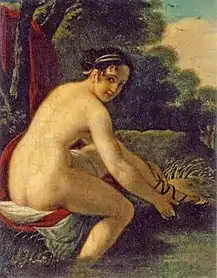 Susannah, 1813
Susannah, 1813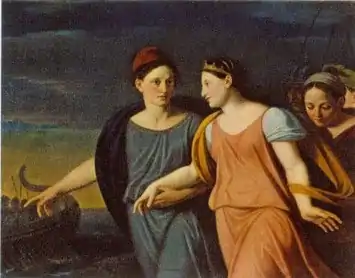
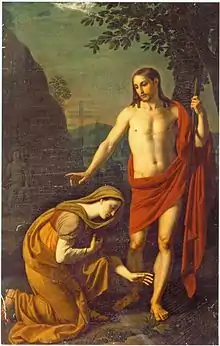 Mary Magdalene, 1818
Mary Magdalene, 1818![Avdotya Golitsyna [ru] as a Vestal Priestess](../I/18307024_Golicuyna.jpg.webp) Avdotya Golitsyna as a Vestal Priestess
Avdotya Golitsyna as a Vestal Priestess
References
- ArtOnline: Biography of Egorov
- RusArtNet: Biography
- Знаменитые россияне 18-19 веков. Биография и портреты (Famous Russians of the 18th and 19th Centuries. Biographies and Portraits) — Saint Petersburg, Лениздат, (1996), pg.764.
- Maria Kamenskaya, Воспоминания (Memories): Художественная литература, (1991)
- "Evdokim Alekseevich Egorov". British Museum. Archived from the original on 8 May 2021. Retrieved 8 May 2021.
External links
![]() Media related to Alexei Yegorovich Yegorov at Wikimedia Commons
Media related to Alexei Yegorovich Yegorov at Wikimedia Commons